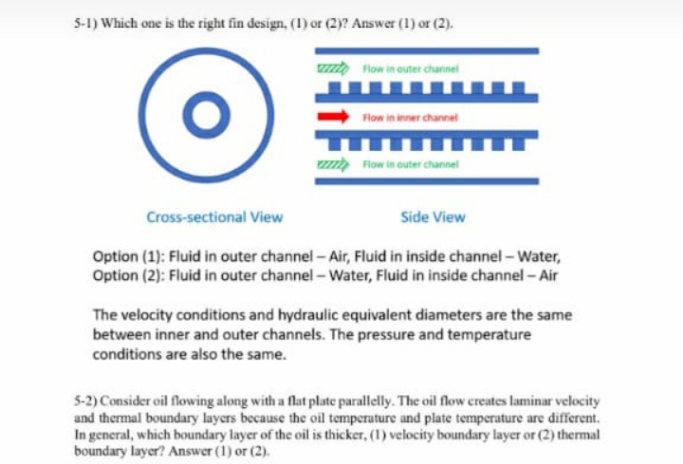5-2) Consider oil flowing along with a flat plate parallelly. The oil flow creates laminar velocity and thermal boundary layers because the oil temperature and plate temperature are different. In general, which boundary layer of the oil is thicker, (1) velocity boundary layer or (2) thermal boundary layer? Answer (1) or (2).
5-2) Consider oil flowing along with a flat plate parallelly. The oil flow creates laminar velocity and thermal boundary layers because the oil temperature and plate temperature are different. In general, which boundary layer of the oil is thicker, (1) velocity boundary layer or (2) thermal boundary layer? Answer (1) or (2).
Elements Of Electromagnetics
7th Edition
ISBN:9780190698614
Author:Sadiku, Matthew N. O.
Publisher:Sadiku, Matthew N. O.
ChapterMA: Math Assessment
Section: Chapter Questions
Problem 1.1MA
Related questions
Question
Urgently required part 2

Transcribed Image Text:5-1) Which one is the right fin design, (1) or (2)? Answer (1) or (2).
ZZZZZ Flow in outer channel
O
Flow in inner channel
ZZZZ Flow in outer channel
Cross-sectional View
Side View
Option (1): Fluid in outer channel-Air, Fluid in inside channel - Water,
Option (2): Fluid in outer channel - Water, Fluid in inside channel - Air
The velocity conditions and hydraulic equivalent diameters are the same
between inner and outer channels. The pressure and temperature
conditions are also the same.
5-2) Consider oil flowing along with a flat plate parallelly. The oil flow creates laminar velocity
and thermal boundary layers because the oil temperature and plate temperature are different.
In general, which boundary layer of the oil is thicker, (1) velocity boundary layer or (2) thermal
boundary layer? Answer (1) or (2).
Expert Solution
This question has been solved!
Explore an expertly crafted, step-by-step solution for a thorough understanding of key concepts.
Step by step
Solved in 2 steps

Knowledge Booster
Learn more about
Need a deep-dive on the concept behind this application? Look no further. Learn more about this topic, mechanical-engineering and related others by exploring similar questions and additional content below.Recommended textbooks for you

Elements Of Electromagnetics
Mechanical Engineering
ISBN:
9780190698614
Author:
Sadiku, Matthew N. O.
Publisher:
Oxford University Press

Mechanics of Materials (10th Edition)
Mechanical Engineering
ISBN:
9780134319650
Author:
Russell C. Hibbeler
Publisher:
PEARSON

Thermodynamics: An Engineering Approach
Mechanical Engineering
ISBN:
9781259822674
Author:
Yunus A. Cengel Dr., Michael A. Boles
Publisher:
McGraw-Hill Education

Elements Of Electromagnetics
Mechanical Engineering
ISBN:
9780190698614
Author:
Sadiku, Matthew N. O.
Publisher:
Oxford University Press

Mechanics of Materials (10th Edition)
Mechanical Engineering
ISBN:
9780134319650
Author:
Russell C. Hibbeler
Publisher:
PEARSON

Thermodynamics: An Engineering Approach
Mechanical Engineering
ISBN:
9781259822674
Author:
Yunus A. Cengel Dr., Michael A. Boles
Publisher:
McGraw-Hill Education

Control Systems Engineering
Mechanical Engineering
ISBN:
9781118170519
Author:
Norman S. Nise
Publisher:
WILEY

Mechanics of Materials (MindTap Course List)
Mechanical Engineering
ISBN:
9781337093347
Author:
Barry J. Goodno, James M. Gere
Publisher:
Cengage Learning

Engineering Mechanics: Statics
Mechanical Engineering
ISBN:
9781118807330
Author:
James L. Meriam, L. G. Kraige, J. N. Bolton
Publisher:
WILEY